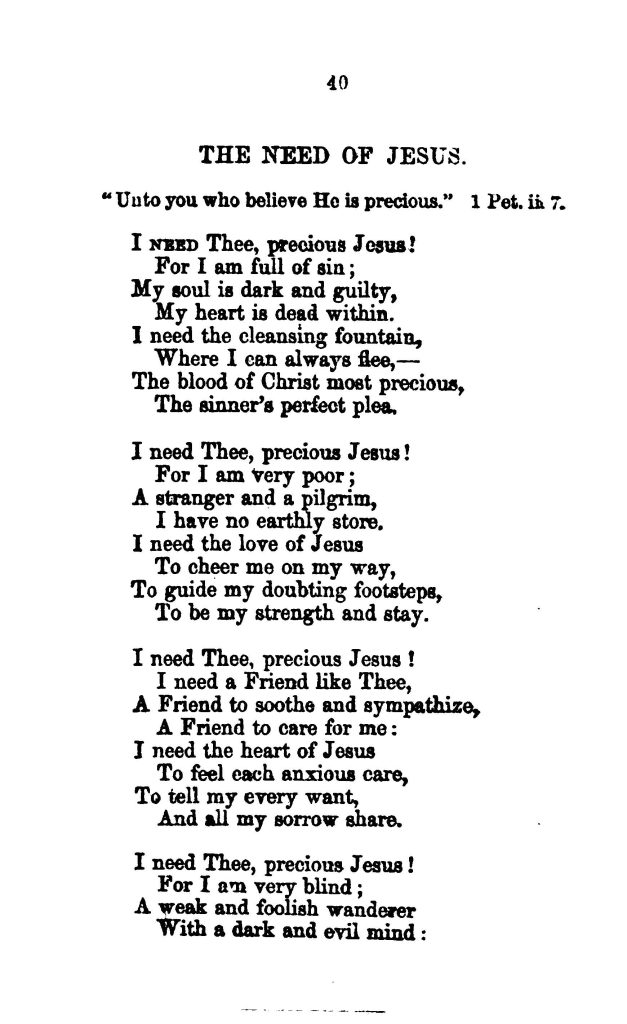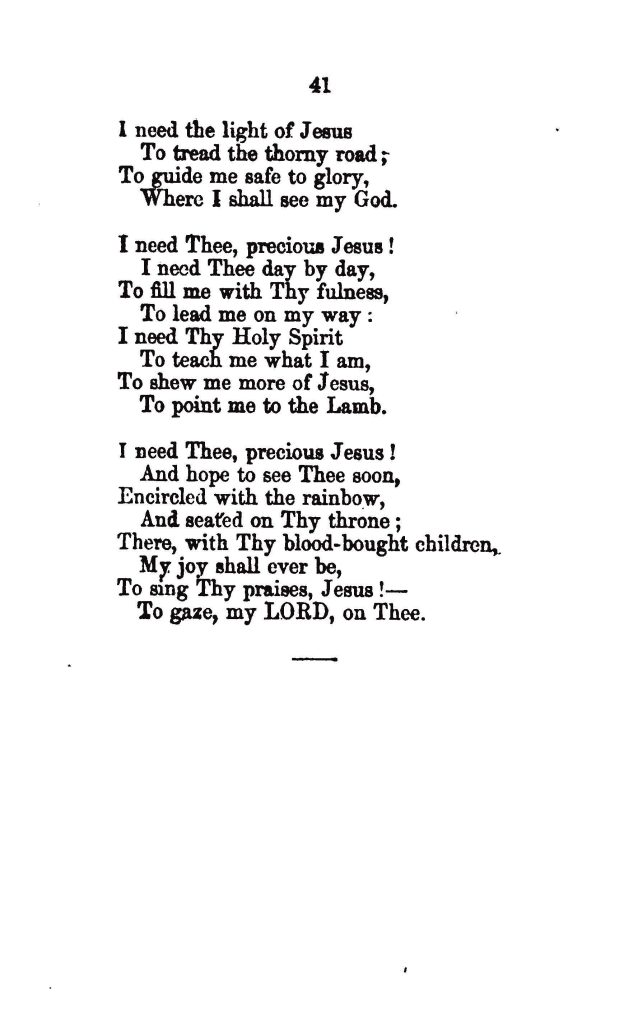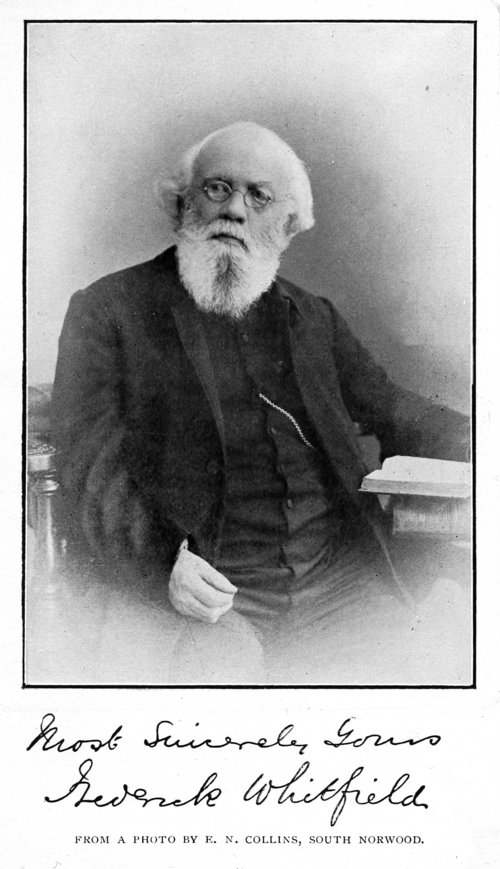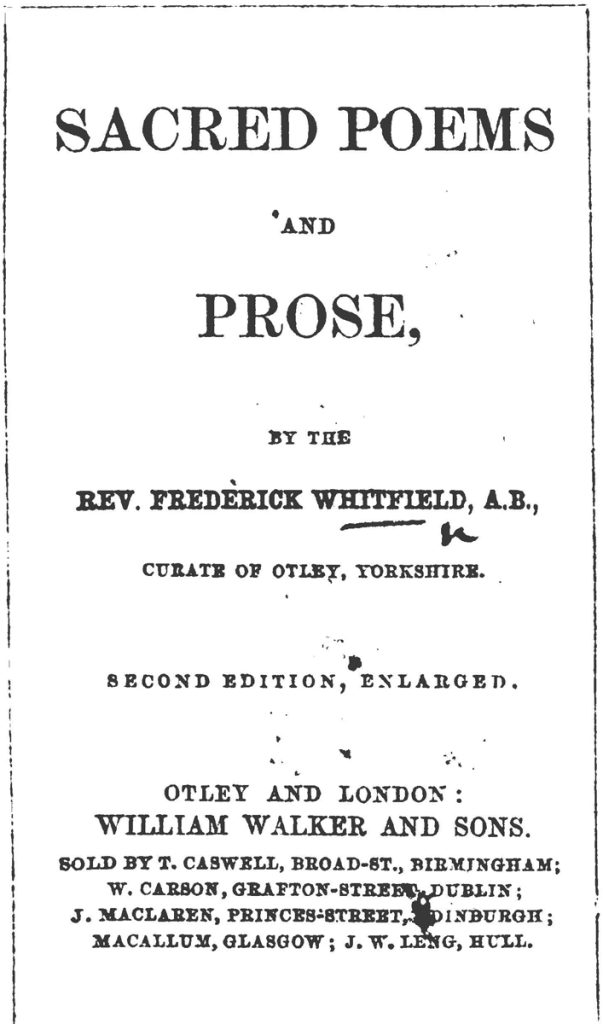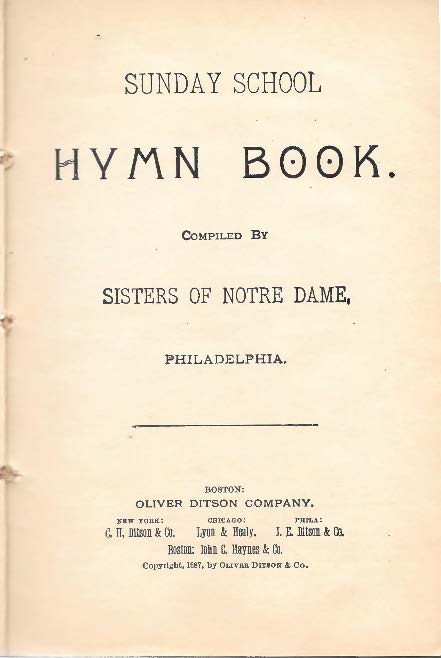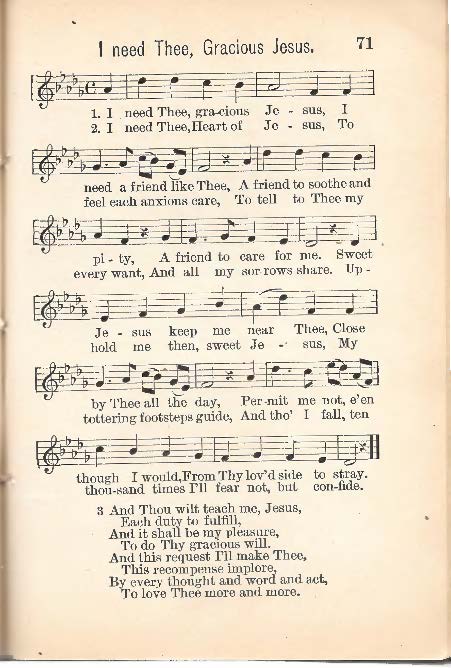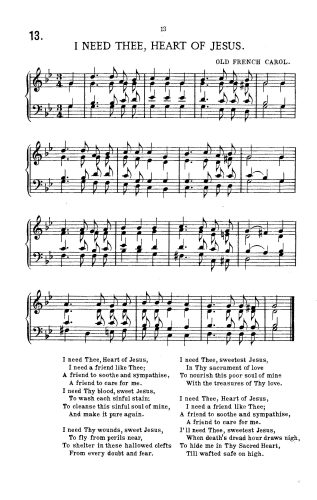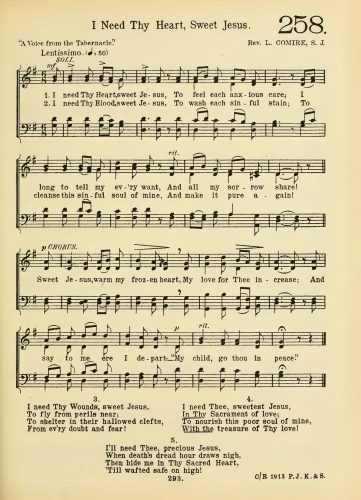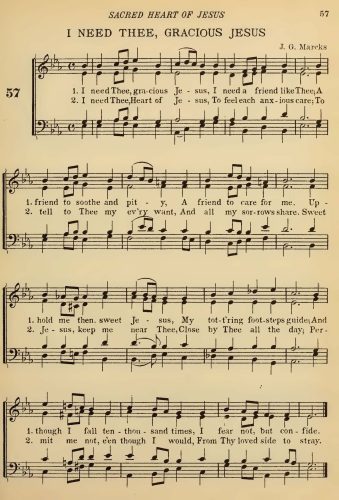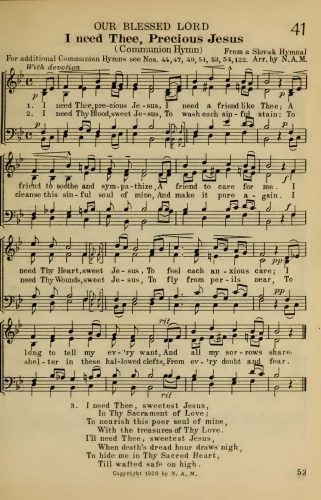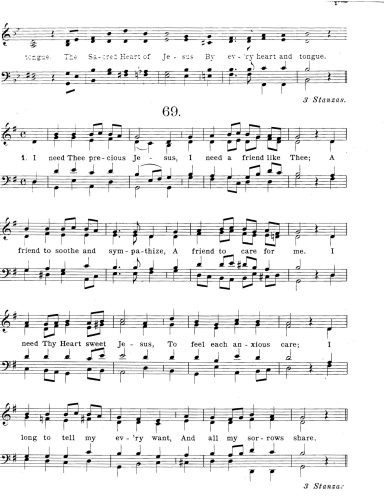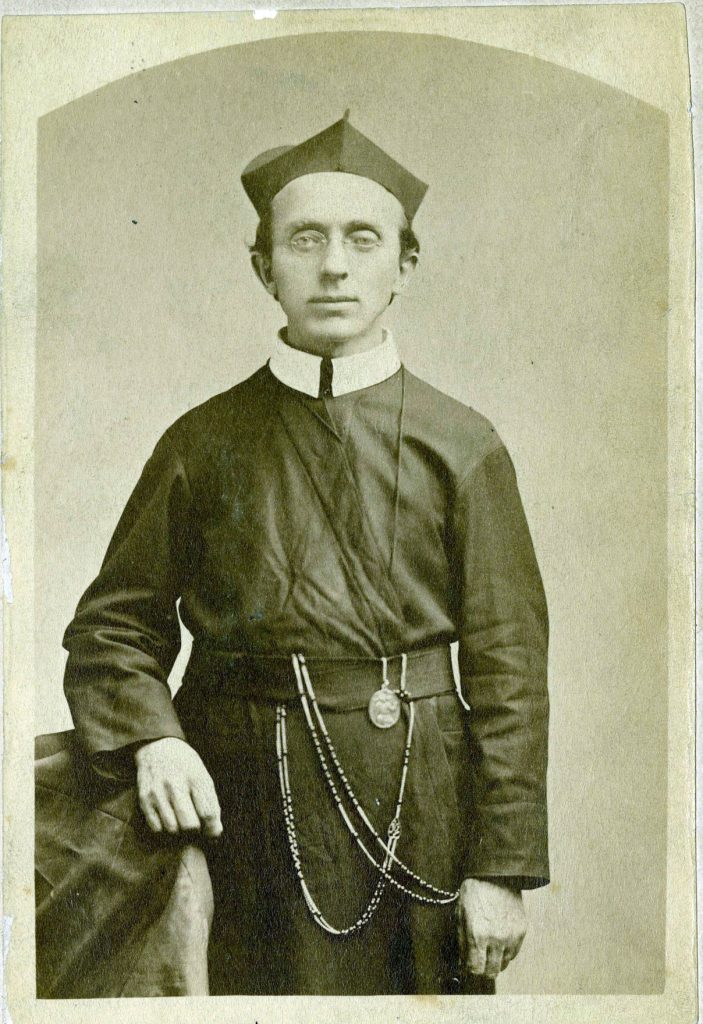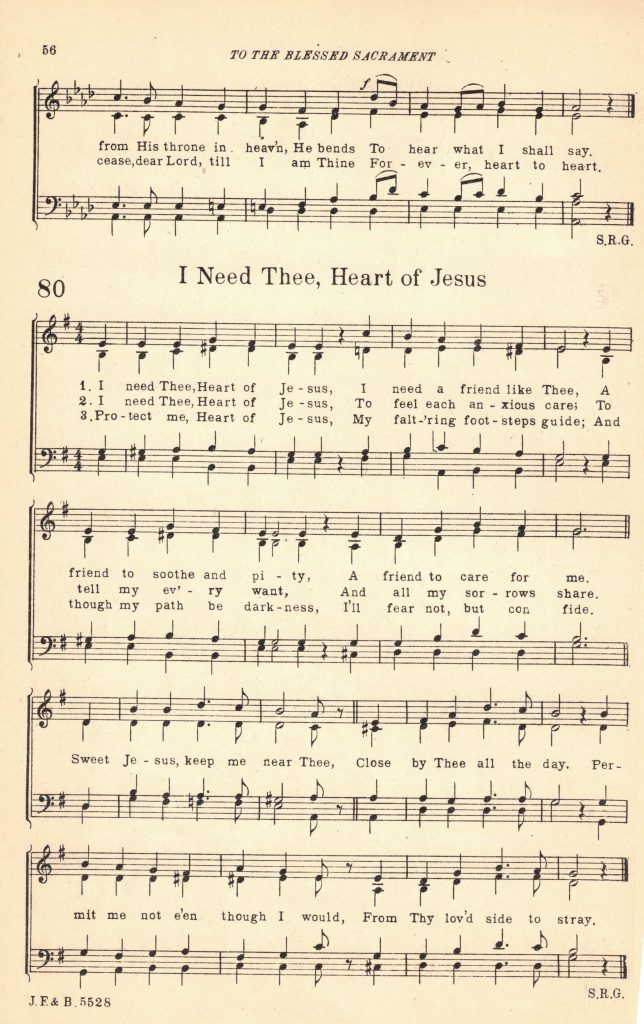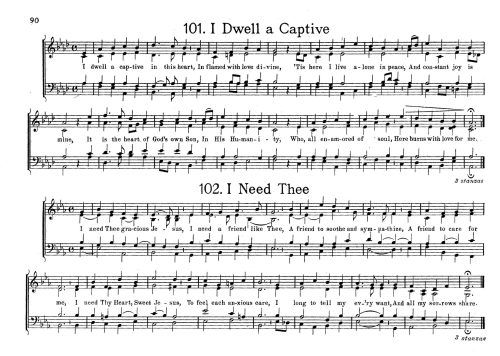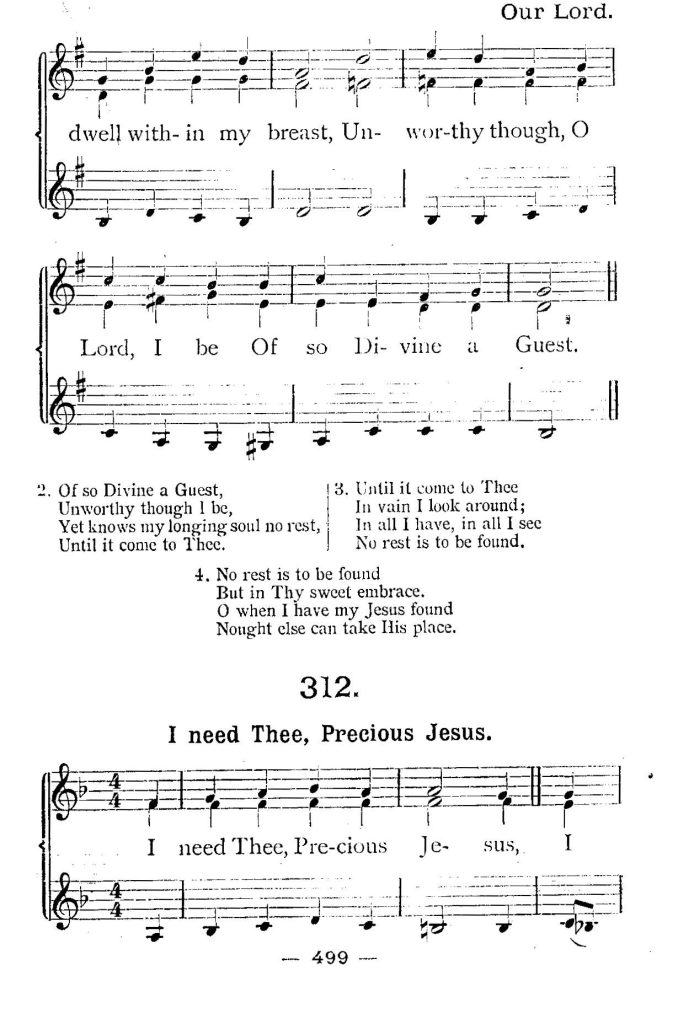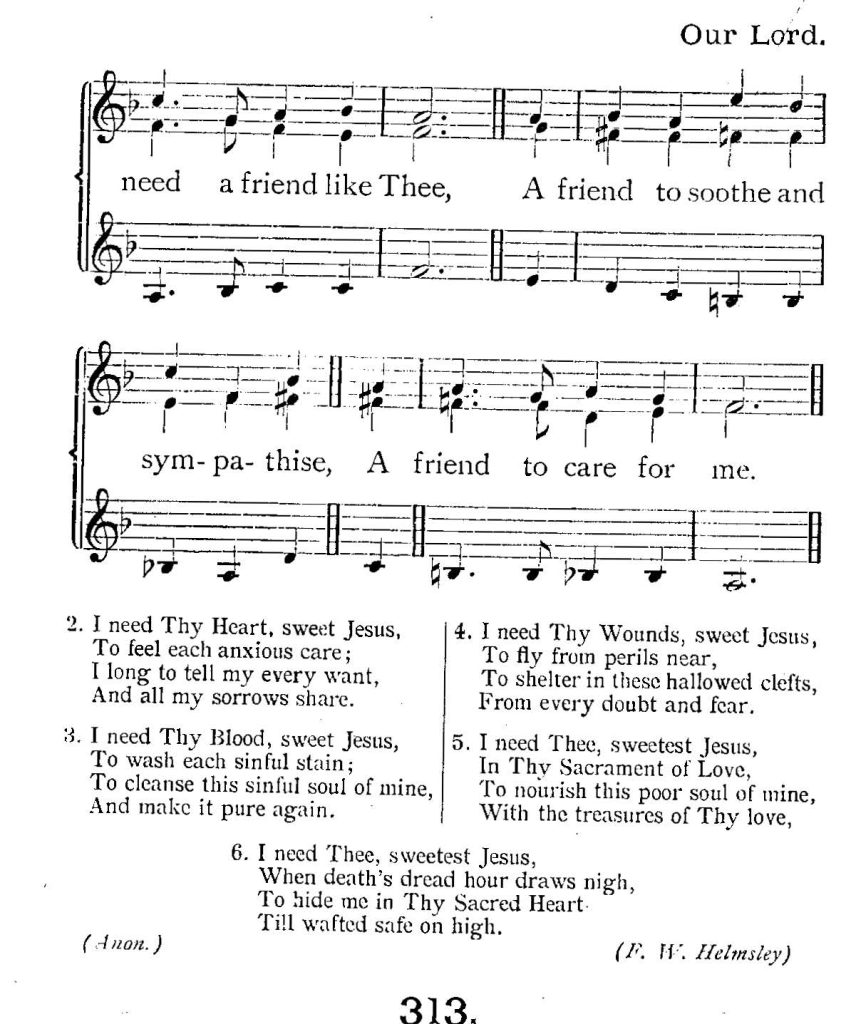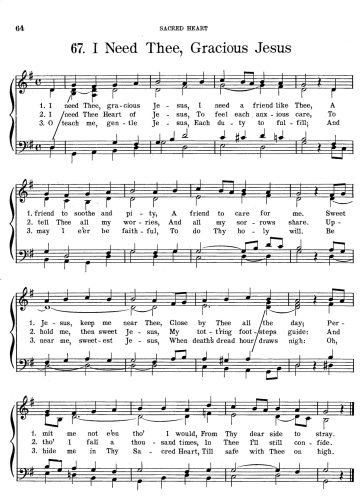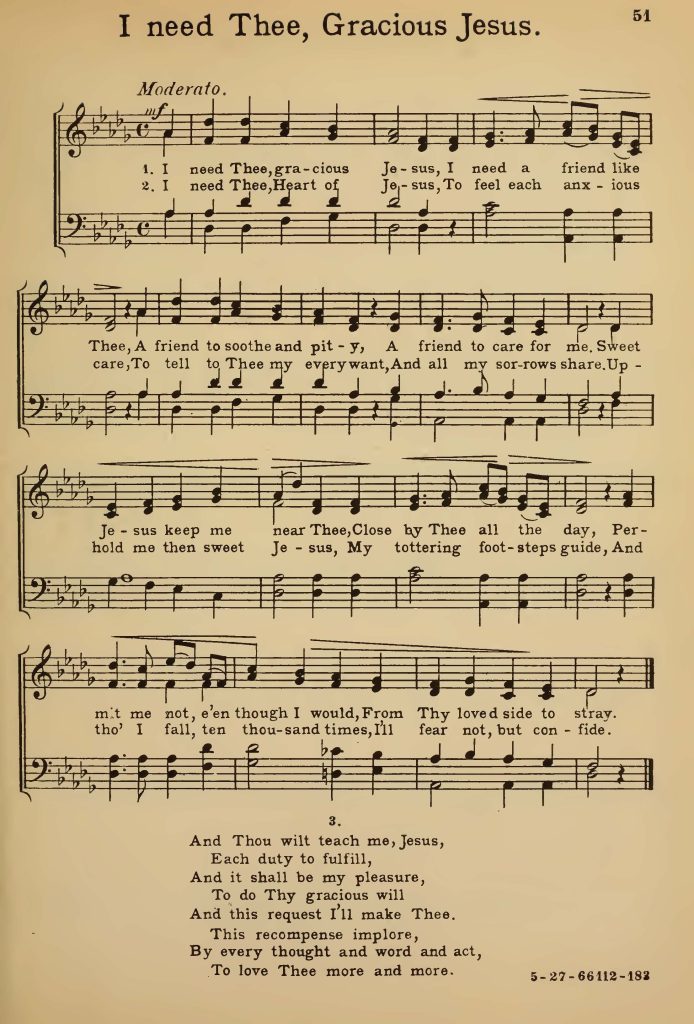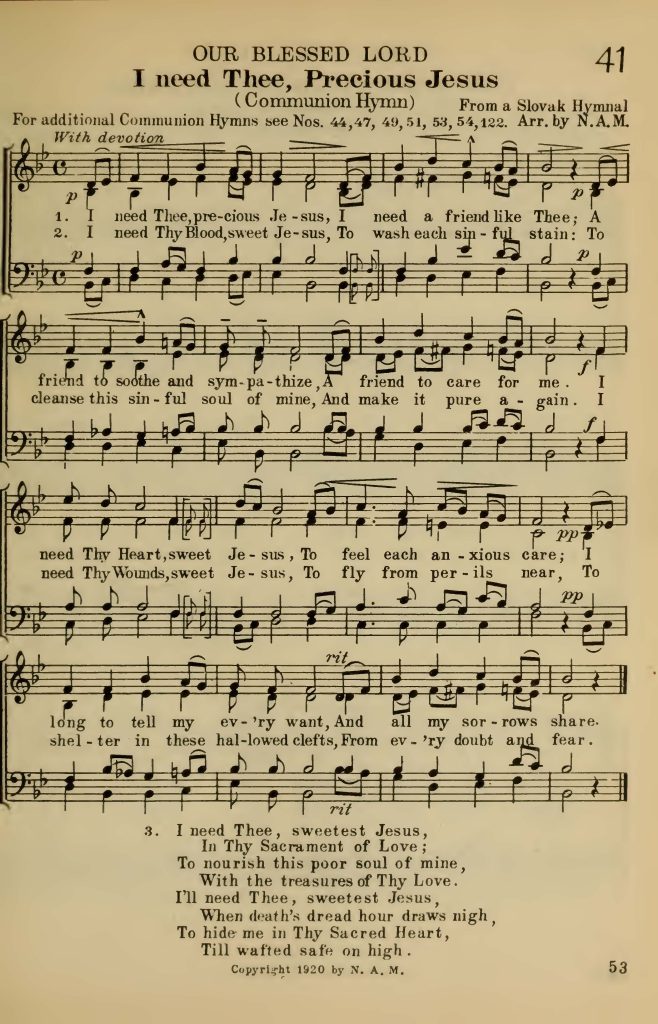This hymn was written by Frederick Whitfield (1827-1904) an Anglican clergyman, and it first appeared in hymn-sheets and leaflets in various languages in 1855, and later in his collection of SACRED POEMS AND PROSE, 1861. (Click on any of the images to enlarge).
Frederick Whitfield was born at Threapwood, Shropshire, England on January 7, 1829. He attended Trinity College in Dublin, Ireland in 1859 where he earned his Bachelor of Arts. He was ordained to the ministry in the Church of England in 1860 and from there held several positions in succession including curate of Otley, Vicar of Kirby-Ravensworth in Yorkshire, senior curate of Greenwich, and Vicar of St. John’s, Bexley. In 1875 he was sent to St. Mary-in-the-Castle, Hastings. He married Sophia Butler, third daughter of Charles Salisbury Butler, Esq. She was born on March 24, 1844 and died at Bournemouth on March 27, 1883.
When the hymn, I Need Thee, Precious Jesus was first published the first verse which begins, I need Thee, precious Jesus, for I am full of sin, was omitted without his permission. By the time corrections were made and reprints issued the omitted version had come into common use and accepted as the original.
Rev. Frederick Whitfield was a prolific author with some thirty works to his credit including: Christ Our Life; Gleanings from Scripture; Voices from the Valley, and Well Springs of Life. Several of his poems became hymns including There is a Name I love to Hear; I have a Great High Priest Above; I saw the Cross of Jesus; Jesus, Thou Name of Power Divine; and I Need Thee, Precious Jesus. The Rev. Frederick Whitfield died at South Norwood on September 13, 1904 after a long and fruitful service in the Church of England. He was 77 years of age.
The verses found in Catholic hymnals were originally altered by a Sister of Notre Dame and they first appeared in the SUNDAY SCHOOL HYMN BOOK, 1887. This collection of hymns was compiled by the Philadelphia Community of Sisters of Notre Dame de Namur.
It was the custom in many religious communities not to give credit to individuals but the whole community and so it is extraordinarily difficult to determine which sister altered the words of this hymn and composed the music. In a previous HYMN OF THE MONTH write-up, there was one Sister out of all the Sisters of Notre Dame who is generally considered the leader in the publication of all the American hymns and songs found in the hymn collections. Her name was Sister Aloysius Josephine Dorman, S.N.D., (1835-1913).
Sister Aloysius was born in Washington, D.C., and entered the congregation at the pioneer Sixth St. Convent, Cincinnati in 1854. Throughout her active years she was a teacher of music and orchestration, publishing songs and hymns for the schools. She taught at Sixth St. Academy, Mount Notre Dame Academy, Reading, Ohio and for many years at Notre Dame Academy, W. Rittenhouse Square, Philadelphia. Sister Aloysius Dorman died April 1, 1913 and is buried in the Notre Dame Cemetery in Hamilton, Ohio.
The Melodies
The hymn appeared in American, British, and Irish hymnals from 1887 thru 1954. A complete list can be found in my Hymnal Survey. The text of the hymn in some hymnals has been changed to favor the Sacred Heart of Jesus. For example, I Need Thee, Heart of Jesus, or I Need Thy Heart, Sweet Jesus. Other alterations appear too, the phrase A friend to soothe and pity is often replaced with A friend to soothe and sympathise. I invite you to read the verses found below and note how they changed over the life of the hymn. In addition to the melody by the Sisters of Notre Dame, there are nine other melodies composed for this hymn.
The first melody is identified as an Old French Carol, and it is found in the St. Cecilia Hymn Book, compiled by Aurthur De Meulemeester (1876-1942) and published in 1911. He was the Organist and Choirmaster at the Clonard Monastery of the Redemptorist Order in Belfast, Ireland a position he held for nearly fifty years.
The second melody was composed by Father L. Comire, S.J., and it appears in the American Catholic Hymnal published in 1913 and 1921. A reference to A Voice from The Tabernacle is given as the source for the words in this hymn. A Voice from The Tabernacle was a series of booklets published for children containing reflections and prayers in Honor of the Blessed Sacrament. I could find little or no information on Father Comire, S.J., except that several of his compositions including Close to Thy Heart and All Ye Choirs of Heaven appear in the hymnal.
A third melody was composed by Joseph G. Marcks (ca. 1900). He was a well-known organist, composer, and piano teacher in New York City. One of his students was George August Fischer of J. Fischer & Brother Music Co., The firm J. Fischer & Brother was once recognized as one of the largest publishers of Catholic Music in the world. Joseph Marcks served at the Holy Name of Jesus Church in 1889 and St. Thomas the Apostle’s Church in 1916. The third melody appears in the De La Salle Hymnal compiled by the Brothers of the Christian Schools (The Christian Brothers) of New York. This group of Brothers also compiled The Catholic Youth’s Hymn Book published in 1871 which saw several printings during the late 19th century period.
A fourth melody is found in the St. Gregory Hymnal and Choir Book published in 1920 and later in the 1940s. This hymnal and choir book was compiled by Nicola A. Montani (1880-1948). He was a conductor, composer, arranger, and publisher of sacred music. He was the cofounder of the St. Gregory Guild and the Society of St. Gregory. The fourth melody which appears in the hymnal is taken from the Duchovny Spevnik Katholicky published in 1907, a Slovak Hymnal. The greater number of Slovak melodies that appear in the St. Gregory Hymnal were taken from the Duchovny Spevnik Katholicky collection.
The fifth melody is taken from Becker’s gesangbuch published in 1872 (Karl Becker 1804-1877) and is found in the St. Mary’s Hymnal published in 1924. This collection was compiled for the Diocese of Toledo, Ohio by Christian A. Zittel (ca. 1920). The hymnal serves as an anthology of traditional German-American hymnody with numerous melodies from German gesangbuchs of the late nineteenth century including the Cologne, Trier, and St. Gall.
About a dozen of the melodies are from collections by Joseph Mohr and other English sources such as the Roman Hymnal. A talented pupil of John Singenberger, Christian Zittel served as organist for fifty years at the Jesuit church, St. Mary’s, Toledo, Ohio. The St. Mary’s Hymnal was published in the same year that John Singenberger died. Christian Zittel helped to further the reform of church music initiated by Toledo’s Bishop Schrembs in 1915.
The sixth melody was found in the Manual of Select Catholic Hymns and Devotions, 1925 edition. This collection of hymns was originally published in 1885 by Father Philip Mary Colonel, C.SS.R, (1843-1925). The organ accompaniment below was provided by Peter Meggison, producer of The Devotional Hymns Project.
The life of Father Colonel is not easily assembled from the records, some of which are still in old German script. His father was French Catholic and his mother Alsatian Lutheran. After the death of his father the family moved to the United States and settled in New York City. The children attended Most Holy Redeemer, the Redemptorists’ German ethnic parish on the Lower East Side, while the mother attended Lutheran services. It is not known when he emigrated to the United States, but at age 17, he entered the Congregation of the Most Holy Redeemer. His brother entered the Redemptorists’ order before him, and his sister become an Ursuline nun. On the day Philip was invested with the Redemptorist habit, his mother became a Catholic. He became a citizen of the United States in 1883.
He was recognized by his superiors to be a powerful preacher, a fatherly Confessor, a great teacher of the faith who was loved by all especially the children and possessed remarkable musical talents. He served in Redemptorist parishes in Annapolis (St. Mary’s), taught in Ilchester, Maryland, at the Redemptorist house of studies there, and served as well in Baltimore, Philadelphia (St. Peter the Apostle), New York (St. Alphonsus), Boston (Our Lady of Perpetual Help, Mission Church), Rochester (St. Joseph’s), Buffalo (St. Mary’s, where he wrote most of his hymnal), and Pittsburgh (St. Philomena).
When Father Colonel died, he had already been at St. Joseph’s Hospital for ten days. His body was transferred to the Chapel of Our Lady of Perpetual Help. Many came to pay their respects to the oldest member of the Baltimore Province. He had been in the order longer than any other man and was a priest for 56 years and professed religious for 65. His funeral was attended by great crowds including the teaching sisters, altar boys, and everyone from church. Father Colonel’s body was then buried at Holy Redeemer Cemetery in the Redemptorists’ plot on March 4, the same day as Calvin Coolidge’s inauguration.
The melody was composed by Samuel Richard Gaines (S.R.G., 1869-1945). Samuel Gaines was an organist, choirmaster, conductor, a teacher of singing, a composer of both secular and sacred music and various works for organ and violin. Many of his compositions and harmonizations are featured in the Cleveland Diocesan hymn books and The Manual of Select Catholic Hymns – 1885 and 1925 editions. Some of his compositions include Come, Sweet Jesus (1885 Manual of Select Catholic Hymns; there may be others in this collection), Sweet, Mother Hear (1928 Cleveland Diocesan Hymnal Part 2 – Devotional Hymns), On This Day, O Beautiful Mother (1928 Cleveland Diocesan Hymnal Part 2 – Devotional Hymns), and few sacred hymns published in 1916 and 1918 respectively, The Holy Land and Hold Thou Me Up. Other works include: The night has a thousand eyes – a part song for mens voices, and Robin Goodfellow – madrigal for mixed voices and two flutes.
The seventh melody is found in the Sursum Corda – A collection of hymns for the use of Catholic Schools published in 1925. This collection was prepared at the request of the Venerable Mother Gerard, Provincial Superior of the Sisters of St. Francis, Stella Niagara, New York. The collection was intended to meet the requirements of the new edition of the prayer book Sursum Corda.
The organ accompaniments were arranged by Father Florian Zettel, O.F.M., (1879-1947). He was an organist at the Church of the Ascension in Portland, Oregon. Father Zettel retained those melodies that he considered suitable and added or supplanted wherever he found a change desirable. When suitable melodies could not be found, he introduced original ones. In the collection, new melodies are marked by a small star and melodies that have been slightly changed are marked by two small stars. Since no stars are indicated on the music the melody must be original, however, as with many Catholic hymnals of the same period, author and composer names are not given. In the Introductory Remarks at the beginning of the collection references are given to Singenberger’s organ book, Mohr’s Cecilia, the works by Father Peter Griesbacher, and others. The hymn is captioned I Need Thee, #102, with three verses or stanzas indicates that those verses were contained in the prayer book or a singer edition of the hymnal.
The eighth melody was composed by Frederick (Frederic) W. Helmsley (b. ca.1880). He was an organist at St. Wilfrid’s in Harrogate (Yorkshire), England. He was a teacher of music for piano, organ and composition. There is a characterization of Helmsley by Gerald Finzi (1901-1956), which suggests that Frederick Helmsley was not a worthy composer to study under. Gerald Finzi was a well-known British composer who studied under Frederick Helmsley in his early musical career. Several of Frederick Helmsley’s compositions appear in A DAILY HYMN BOOK, published in 1932 and 1948 by Burns Oates & Washbourne Ltd.
The ninth melody is found in the Laudate Choir Manual, 1942. This diocesan hymnal was compiled by Father Joseph Hohe at the request of Bishop Thomas L. Lillis of Leavenworth, Kansas in 1904. Bishop Lillis initiated a program of liturgical reform in conformity of the recently promulgated Motu Proprio of Pope Pius X. A melody edition titled Laudate containing English hymns, music for the Mass, and other parish services was published in 1909.
The Laudate continued as the official choir book and in 1942 Bishop Paul Schulte approved the revised edition prepared by Father Herman Koch and Father Andrew Green, O.S.B. Also at this time the copyright was turned over to the McLaughlin and Reilly Company. The last edition was published in 1957. Father Hohe who originally compiled the hymnal died on January 20, 1925.
Reflection
The Choir of St. Mary’s in Akron, Ohio under the direction of Ralph Jordan sang this hymn using two arrangements. That of the Sunday School Hymn Book and from the St. Gregory Hymnal and thus I am familiar with both of these melodies, but my favorite melody is by the Sisters of Notre Dame.
The verses are very prayerful calling out to Jesus for friendship, I need Thee, gracious Jesus, I need a friend like Thee. How many of us have need of a friend like Jesus? Someone who really understands our needs, a friend to care for me. We petition Jesus to keep us near to Him, Jesus, keep me near to Thee, Close by Thee, all day. The first verse ends with a plea to Jesus to be patient with us, permit me not, e’en though I would, from Thy loved side to stray.
How tender are the words in the second verse, I need Thee, Heart of Jesus, a friend who truly feels each anxious care, and who knows our anxieties and sorrows, and all my sorrows share. He knows our difficulties, he knows the weight of the cross we bare and though I fall ten thousand times, I’ll fear not but confide, what a beautiful allusion to the Sacrament of Confession.
At St. Mary’s the choir would sing this hymn at Offertory, Communion, when there were devotions to the Sacred Heart, or as a prelude and usually to the melody found in the SUNDAY SCHOOL HYMN BOOK.
A special thank you to the Redemptorist Archives, Philadelphia for providing the photos of Father Philip Mary Colonel, C.SS.R., and the biographical details of his life.
Also, a special note of thanks to the Catholic Music Association of America forum members for their assistance in providing links to Frederick Helmsley.
This hymn has been forgotten by all except for a few vintage organists, hymnologist, and choir members like myself. This is a very beautiful hymn to sing especially in these days when we read about and hear of the need to have a personal relationship with Jesus. Ask your organist or choir director to sing this wonderful hymn at your next Mass.
Below are computer generated sound files of the melodies presented above. The tempo is approximate but should provide the listener with a good sense of what the hymn sounds like. All the hymns are in the public domain. Music directors, if you use any of these selections in your Sunday or weekly music programs and you make a recording, contact the author and I may feature it in the What’s New section of the website.

